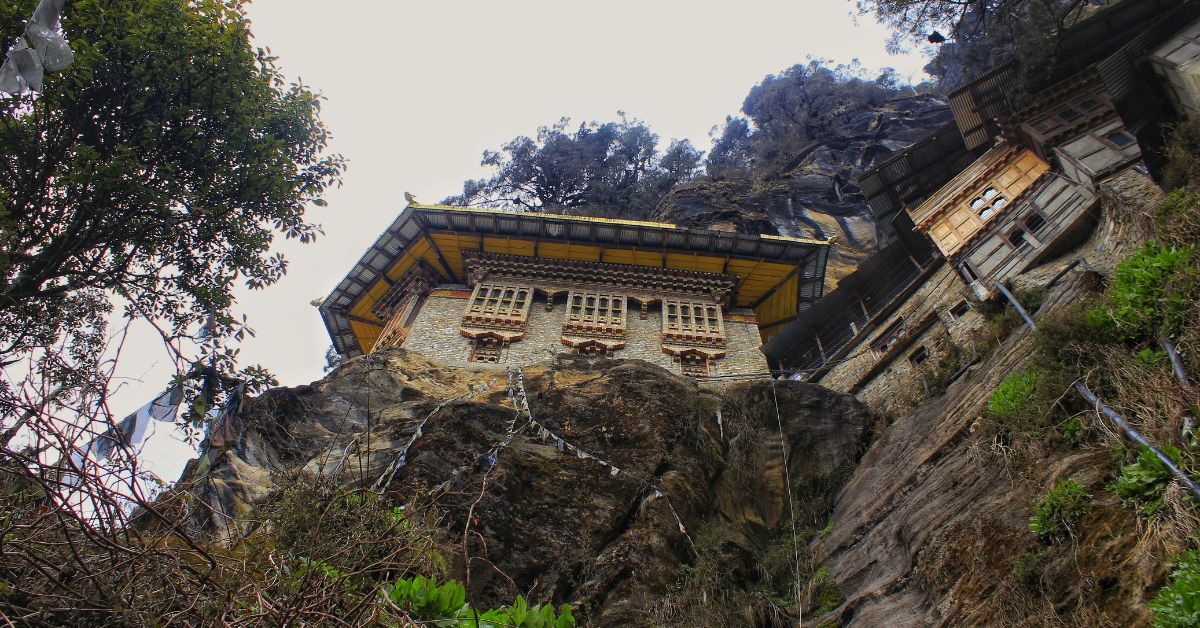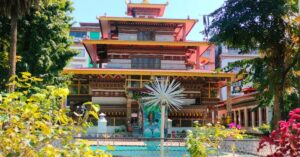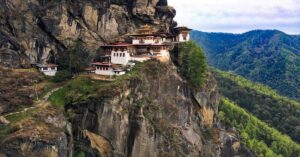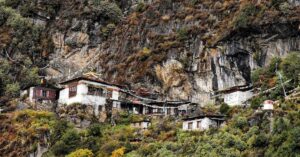Baylangdra Ney is a sacred place where Guru Rinpoche meditated and conquered the local spirit Lhatsen Langdra. The Baylangdra Nye is located in Kazhi Gewog under Wangdue Phodrang Dzongkhag at an altitude of 2989 meters above sea level.
Baylangdra Ney is one of the three holiest Neys of Guru Rinpoche in Bhutan, the other two being Paro Taktsang and Singye Dzong. Kyabje Chatral Rinpoche discovered Baylangdra in 1988.
How to Reach Baylangdra
After driving through Wangdue, you will follow a dirt road to the left leading toward Chuzomsa. It is an hour’s drive from Chuzomsa through the ravines of the Sha villages. From the road end, the sacred site of Baylangdra ney is an hour and a half walk.
Sacred Relics to See at Baylangdra
Here are the sacred relics found in Baylangdra nye:
- A 10-foot-tall statue of Urgyen Dorje Gur;
- The imprints of Guru Rinpoche’s body on the rock;
- A holy water;
- A right footprint of Guru Rinpoche;
- A hat of Guru Rinpoche;
- The rock, which has the shape of Guru Rinpoche’s Reldri, and the bull towards the northeast of the cave;
- A walking staff of Guru Rinpoche;
- A sword;
- A stone vase of immortality
- A pair of conch;
- A trace of dripping water from the vase, which can extend one’s life to 100 years;
- The Tongue of the Ox;
- The image of the door guard Scorpion;
- A track believed to lead to heaven;
- A sacred rock engraved with the magical seal.
Also Read: Guru Rinpoche’s Visits to Bhutan and His Sacred Sites
Historical Significance of Baylangdra
When Guru Rinpoche was in Nga-yap-Ling, a continent north of Jambudvipa, he saw in his spiritual vision the people of a decadent age suffering and plagued by ignorance and sinful deeds.
Provoked by their sympathetic situation, Guru Rinpoche came to Baylangdra to save them. He came donning himself as a poor old man. The people living in that place were surprised to see the stranger. Thus, the place was called Goensarkha (Goen: guest; Sar: new; Kha: place). Here, one can see the imprints of Guru Rinpoche’s body on the rock in this place. It is said that the people of Goensarkha suffered from drought, and Guru Rinpoche dug out a spring of holy water (Drupchhu) to quell the thirst of the people. The holy water of Guru Rinpoche can still be seen today.
Also Read: Drupchhu or Holy Spring Waters in Bhutan: Beliefs and Benefits
The Fulfillment of Guru Rinpoche’s Wish
To discover the hidden treasures from Baylangdra, Guru Rinpoche planted his staff on the ground and wished that if the treasure was to be discovered, the staff would grow into a tree and, if not, perish. The staff grew into a fresh cypress tree.
Favored by the fulfillment of his wish, he remained in profound meditation for seven days in the cave. The spirit of that place named Lhatsen Langdra (Terdak Langdrapa) turned himself into a red bull and performed miracles to disturb Guru Rinpoche’s concentration. Guru Rinpoche manifested as Pejung Dorji Gurden and chopped the bull into pieces with the Reldri (sword).
Seared by the pain, Terdak Langdrapa submitted to follow any orders of Guru Rinpoche and let the future practitioners attain the yogi. Guru Rinpoche made him the place’s protecting guardian deity, calling him Genyen Langdrakpa. The evidence of this incident is visibly displayed by the rock towards the northeast of the cave, which has the shape of Guru Rinpoche’s Reldri and the bull. The name of this sacred site became Beyul Langdra, meaning ‘The Hidden Treasure of the Bull Cliff’.
Then, Guru Rinpoche sanctified the place, hid 50 holy treasures, and faded into a rainbow.
The Importance of Baylangdra Nye
Why is Baylangdra Nye important? Baylangdra in Bhutan is important as it is the sacred site of Guru Rinpoche where he meditated for seven days & conquered the local spirit and concealed numerous treasures.
The Ney is also important as the place was blessed and consecrated by many great Buddhist Masters such as Kuenkhen Longchen Rabjampa.
Bey Langdra was visited by Kunkhyen Longchenpa in 1356, followed by his son Tersay Drakpo Ozer. Later in Sha Kunzangling, the seat of Kunkhen Longchen Rabjampa, Terdak Langdrakpa instructed Terton Dorje Lingpa to visit Bey Langdra. After visiting and staying there for seven days, Dorje Lingpa was disappointed after finding no spiritual indications. However, when just about to leave, a Dakini appeared before Him and instructed Him to look at the cliff. He saw Guru Rinpoche as an eight-year-old boy on the cliff emanating from a rainbow.
The Guru thus instructed him, “My son, do not leave. You are the destined treasure revealer.” Accordingly, Terton entered a retreat. Guru Rinpoche again appeared to him on the 10th day of the eighth month in retreat.
The Guru instructed him that, if one merely sees Bey Langdra, one will be freed from samsara. If one visits it, all defilements will be purified. If one practices Dharma there, one will find spiritual fulfillment and realize all the Yidam practices. If one makes offerings here, all aspirations for all lifetimes will be fulfilled.
Popular treasure discoverers like Pema Lingpa, Dorji Lingpa, and Sherab Mebar also paid a visit to Beylangdra over the centuries. Baylangdra Ney is one of the three holiest Neys of Guru Rinpoche in Bhutan, the other two being Paro Taktsang and Senge Dzong.
Also Read: Paro Taktsang (Tiger’s Nest), the Sacred Place of Guru Rinpoche’s Enlightened Mind, and Singye Dzong, The Mystical Lion Fortress of Guru Rinpoche
Discovery of Baylangdra Nye
Who discovered Baylangdra? Kyabje Chatral Rinpoche discovered Baylangdra in 1988.
The sacred site of Baylangdra in Bhutan remained in ruins for centuries despite being blessed by Guru Rinpoche and several Tertons. It was not until the 14th Je Khenpo Tenzin Namgyel revived and restored the significance of the place.
A temple was constructed at the sacred site by the ancestors of Tshampa Wangyel and was taken care of generation after generation until Lungten Trulku took over it. The Trulku reconstructed and extended it into a two-storeyed temple with new relics installed inside.
In 1986, Lungten Tulku went to Yolmo in Nepal and approached Kyabje Chatral Rinpoche about Bey Langdra. Kyabje Chatral Rinpoche visited Bhutan, and Baylangdra was formally discovered by Kyabje Chatral Rinpoche in 1988.
Chatral Rinpoche went on to say that while the world is full of spiritually significant sites, the discovery of Bey Langdra is particularly important. First, it has a sacred legacy, and second, it has not been defiled over time. Chatral Rinpoche also remarked that all Bhutanese who could now visit the site had more merit than those who had passed away. Probably due to its late discovery, it is considered one of Bhutan’s most sacred and undefiled religious sites.
Also Read: The Discovery of Rangtse Ney
Description of Baylangdra
Diverting towards Baeyul Langdra from the main highway at Chuzomsa, to the left, you see a rock in the middle of the Baechhu. This rock is not ordinary; it is considered the hat of Guru Rinpoche, and it is believed that the key to opening the door of the hidden land of Baeyul Langdra is hidden beneath it. From Ney Wogmin Chhoeying, it takes 10 minutes to reach Baeyul Langdra Ney.
On the way through the beautiful forests, you will pass many temples, including the old Zhabjay Lhakhang, where you can see a defined right footprint of Guru Rinpoche and beautifully carved handmade wall paintings. Additionally, you will pass a cave with water dripping through the roof, though there seems to be no water source. Just before reaching the hike’s starting point, you will spot Guru Rinpoche’s walking stick, enormous old cypress trees stuffed with the craftsmanship of great lamas.
Around the temple, you can see a footprint of Guru Rinpoche, a sword and a stone vase of immortality, a pair of conch, and a trace of dripping water from this vase, which can extend one’s life to 100 years. You can also see the tongue of the Ox.
Baylangdra Temple
There are two big Baylangdra temples at the trailhead; the upper one is a meditation retreat, and the lower one, Yoser Namseling Lhakhang, is a two-storied temple with beautiful sculptures of Guru Rinpoche’s eight manifestations. The Baylangdra Temple was built by Lungten Tulku in 2000.
According to Chatral Rinpoche’s instructions, a retreat center named Drubdra Ozer Samtenling was constructed at the foot of the valley. In 2000, Chatral Rinpoche appointed Lungten Tulku as the destined Lama to build a Lhakhang in Bey Langdra. Tulku constructed a small Lhakhang. Inside the temple, on the face of the cliff, you can see the seal of Guru Rinpoche, the image of the door guard Scorpion, and a track believed to lead to heaven.
The Lhakhang housed a 10-foot-tall statue of Urgyen Dorje Gur made in Punakha and two six-foot-tall statues of Khandro Yeshe Tshogyal and Khandro Mandarawa. They were sponsored by HRH Ashi Deki Yangzom.
Cypress Tree at Beyul Langdrak
The origin is believed to be the walking stick of Guru Rinpoche, who visited Beyul Langdra in the 8th century. The tree caters to the locality as a symbol of worship and blessings.
Baylangdra in Bhutan is one of three sacred sites of Guru Rinpoche where Guru Rinpoche planted his walking stick. The other two are the Cypress tree in Kurjey Lhakhang in Bumthang and the Cypress tree in Dechen Phodrang Ney in Trashi Yangtse.
The story of the Baylangdra cypress tree is both intriguing and surprising. It is said that to discover the hidden treasures from Baylangdra, Guru Rinpoche planted his staff on the ground and wished that if the treasures were to be found, the staff would grow into a tree, and if not, it would perish. No sooner did he wish and plant it than the staff grew into a fresh cypress tree. If you look from a distance, the fork at the top of the cypress tree, where Guru placed his palm, is visible. It is said that the tree contains relics and bestows blessings equal to those of five monasteries.
The Baylangdra cypress tree is visited by a lot of people from faraway places. They take the bark, branches, twigs, leaves, and cones to be used as blessings. You are advised not to harm the sacred cypress tree.
Also Read: Kurjey Lhakhang, where Guru Rinpoche left his Body Impression in a Cave
The Tsenden Tsechu Festival of Baylangdra Nye
The people of Bay Chiwog observe a day to commemorate the auspicious event of planting the walking staff of Guru Rinpoche at Baylangdra in the 8th century, known as ‘Tsenden Tshechu’. The Tsenden Tshechu is conducted annually on the 15th day of the 8th month of the Bhutanese calendar.
During the Tshechu, all the households of Bay Chiwog gather in the small flat area around the cypress tree and circumambulate the prayer wheels surrounding the majestic tree. During the day-long ritual, the community relishes and relaxes in the Tshechu atmosphere the entire day. The festival is sponsored by the community members.
Also Read: The Unique Tshechu of Dzongdrakha
Best Time to Visit Bey Langdra
You can visit Baylangdra in Bhutan at any time of the year. However, if you love to witness the special celebration, you must visit Baylangdra on the 15th day of the 8th month of the Bhutanese calendar, which usually falls between September and October. On this day, the locals of Bay Chiwog gather in the small flat area around the cypress tree to celebrate the day-long ritual known as ‘Tsenden Tsechu’ to commemorate the event of the Guru’s staff growing into a huge cypress tree in the 8th century. You can visit the major pilgrimage sites of Wangdue Phodrang with the Bhutan Pilgrimage Package.
Other Sacred Sites to Explore in Wangdue Phodrang
Dechen Draphu: Also known as Dechendrak or the “Cliff of Great Bliss,” it is one of the four sacred cliffs entrusted to Phajo Drugom Zhigpo by Guru Rinpoche in a prophetic vision during the 13th century.
Frequently Asked Questions
Where is Baylangdra Nye located?
Baylangdra Nye is located in Kazhi Gewog under Wangdue Phodrang Dzongkhag at 2500–3000 meters above sea level.
Why is Baylangdra Nye important?
Baylangdra Nye is important as it is a sacred site where Guru Rinpoche meditated for seven days, conquered the local spirit, and concealed numerous treasures. The site is also important as it was blessed and consecrated by many great Buddhist Masters such as Kuenkhen Longchen Rabjampa, and popular treasure discoverers like Pema Lingpa, Dorji Lingpa, and Sherab Mebar.
What do people do to preserve the Baylangdra Nye?
The people engage in various activities that promote the preservation of Baylangdra Nye. They actively manage and maintain the Nye, ensuring they remain sacred and functional for future generations.
Who discovered Baylangdra Nye?
Baylangdra Nye was discovered by Kyabje Chatral Rinpoche in 1988.
What do people think about Baylangdra Nye?
People have a deep spiritual connection with Baylangdra Ney, considering it a sacred site blessed by Guru Rinpoche and other important Buddhist masters. Baylangdra Ney is also regarded as one of the three holiest Neys of Guru Rinpoche in Bhutan, the other two being Paro Taktsang and Singye Dzong.
What is the significance of the Tsenden Tshechu festival?
The significance of the Tsenden Tshechu festival is that it commemorates the event where Guru Padmasambhava planted his walking stick at Baylangdra to spread Buddhism.
Enjoyed reading this blog?




